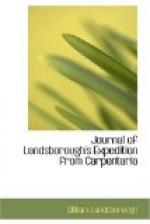February 25.
Number 13 Camp is situated on the right bank of the Flinders River at a point about four miles distant from Fort Bowen and north-west and by west from it. Looking from the camp, the hill had a long-topped aspect with rather an abrupt western termination. During the night the weather was showery and this morning rain fell, accompanied by a strong north-east wind. Left camp at 8.47 a.m. and reached the base of Fort Bowen in four and a half miles at 10.25. In coming that distance we crossed plains which had, near the river, more herbs than grass; and near the hill more grass than herbs. At the base we found springs surrounded by reeds and clumps of tea-trees. Accompanied by Jemmy I ascended Fort Bowen, the rest of the party proceeding up the river. From the summit I observed two little hills in the distance bearing 60 degrees east of south. From the density of the atmosphere no other hills were visible. Plains surround Fort Bowen on all sides. Those on the west side of the Flinders River are more thickly wooded than those on the east side. Fort Bowen, I should say, is about 200 feet high. From its surface pudding-stone rocks crop out. Almost immediately after descending we overtook the rest of the party, halting near waterholes in which there were ducks. Jackey and Fisherman had tried to kill some but without success; at 12.18 Mr. Bourne and Jackey went to shoot at a large flock of cockatoos, the rest of us proceeding on our journey; at 2.55 came south-east and by south over rich plains with more herbs on them than grass at places, and more grass than herbs at other places, seven miles, and encamped. Before we halted Mr. Bourne and Jackey overtook us, loaded with cockatoos, of which they had shot as many as they wanted as the flock did not fly away. Distance today eleven and a half miles.
February 26.
Jemmy and Jackey went out early for the horses. Shortly after noon they returned having only found a portion of them. They brought back two snakes and ate them for dinner. Jackey was bitten by one of the reptiles but so slightly that he did not think anything of it. Snakes are rare in this part of the country. In my last expedition to the south-west I only remember having seen one. In the evening Fisherman brought in the remainder of the horses. The weather was showery, accompanied by northerly wind for the greater part of the day.




